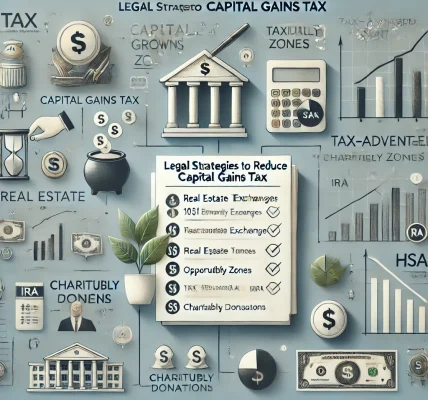Introduction
Building wealth through smart investing is a key financial goal, but many investors overlook a crucial factor: tax efficiency. Without a proper tax strategy, a significant portion of your investment gains could be lost to taxes, reducing your overall returns. By understanding and implementing tax-efficient investment strategies, you can legally minimize your tax burden while maximizing wealth growth.
This DIY guide will help you navigate tax-efficient investment strategies to ensure you grow your wealth while paying less in taxes.
1. Understanding Tax-Efficient Investing
Tax-efficient investing focuses on minimizing tax liabilities to maximize after-tax returns. The key components include:
- Tax-advantaged accounts (e.g., IRAs, 401(k)s, HSAs)
- Tax-efficient asset allocation
- Minimizing capital gains taxes
- Using tax-loss harvesting
- Holding investments for the long term
Pro Tip: The less tax you pay on investment gains, the faster your wealth compounds.
2. Utilize Tax-Advantaged Accounts
One of the simplest ways to reduce taxes is by investing in tax-advantaged accounts:
Retirement Accounts
- 401(k) & 403(b) Plans: Contributions are tax-deferred, reducing taxable income. Growth is tax-free until withdrawal.
- Traditional IRA: Contributions may be tax-deductible, and earnings grow tax-deferred.
- Roth IRA: Contributions are made with after-tax money, but qualified withdrawals are tax-free.
Health Savings Accounts (HSAs)
- Contributions are tax-deductible.
- Investments grow tax-free.
- Withdrawals for qualified medical expenses are tax-free.
- At age 65, you can withdraw funds for non-medical expenses without penalties (but subject to income tax).
Best Practice: Max out contributions to tax-advantaged accounts before investing in taxable accounts.
3. Optimize Asset Location for Tax Efficiency
Different types of investments have different tax treatments, so where you hold them matters.
Best Assets for Tax-Advantaged Accounts:
- Bonds (Taxable and High-Yield)
- REITs (Real Estate Investment Trusts)
- Actively Managed Mutual Funds (due to frequent capital gains)
Best Assets for Taxable Accounts:
- Index Funds & ETFs (low turnover, fewer taxable events)
- Municipal Bonds (tax-free interest income)
- Individual Stocks (held long-term to benefit from lower capital gains tax)
Pro Tip: Taxable bonds and high-dividend stocks are best placed in tax-deferred accounts to avoid immediate tax liability.
4. Minimize Capital Gains Tax
Long-Term vs. Short-Term Capital Gains
- Short-term capital gains (held < 1 year): Taxed as ordinary income (higher rates).
- Long-term capital gains (held > 1 year): Taxed at preferential rates (0%, 15%, or 20%).
Strategies to Reduce Capital Gains Taxes:
- Hold investments for at least one year to qualify for long-term capital gains rates.
- Use tax-loss harvesting (sell losing investments to offset taxable gains).
- Gift appreciated assets instead of selling them (reduces taxable income).
- Invest in Opportunity Zones (allows deferral and potential elimination of capital gains tax).
Best Practice: Avoid frequent trading to minimize short-term gains and associated taxes.
5. Take Advantage of Tax-Loss Harvesting
Tax-loss harvesting allows you to offset capital gains by selling investments that have declined in value.
How Tax-Loss Harvesting Works:
- Sell an investment that has declined in value.
- Use the loss to offset capital gains from other investments.
- If losses exceed gains, you can offset up to $3,000 per year against regular income.
- Unused losses can be carried forward indefinitely.
Caution: Be aware of the wash-sale rule—you cannot repurchase the same or a substantially identical asset within 30 days before or after the sale.
6. Invest in Tax-Efficient Funds
Some investments are structured to be more tax-efficient:
- Index Funds & ETFs: Lower turnover means fewer taxable capital gains distributions.
- Municipal Bonds: Interest income is often federal tax-free and sometimes state tax-free.
- Tax-Managed Funds: Designed to minimize capital gains distributions.
Pro Tip: Avoid actively managed funds in taxable accounts, as they generate frequent taxable distributions.
7. Consider Charitable Giving Strategies
Donating assets instead of cash can provide significant tax benefits.
Tax-Efficient Charitable Giving Strategies:
- Donate Appreciated Stocks: Avoid capital gains tax and claim a charitable deduction.
- Qualified Charitable Distributions (QCDs): Individuals over age 70½ can donate up to $100,000 per year from IRAs tax-free.
- Donor-Advised Funds (DAFs): Make tax-deductible donations while spreading distributions over multiple years.
Best Practice: Charitable giving can be a win-win, benefiting both your tax bill and philanthropic efforts.
8. Utilize Roth Conversions to Manage Future Taxes
A Roth conversion allows you to move money from a Traditional IRA to a Roth IRA, paying taxes now to avoid higher rates later.
When to Consider a Roth Conversion:
- During years with low taxable income.
- Before reaching Required Minimum Distributions (RMDs).
- If you expect to be in a higher tax bracket in retirement.
Pro Tip: Convert strategically to avoid pushing yourself into a higher tax bracket in a single year.
9. Plan for Required Minimum Distributions (RMDs)
Once you reach age 73 (starting 2023), you must begin withdrawing from Traditional IRAs and 401(k)s. These RMDs are taxable.
How to Reduce RMD Taxes:
- Convert funds to a Roth IRA before RMDs begin.
- Donate RMDs to charity via Qualified Charitable Distributions (QCDs).
- Withdraw strategically to avoid higher tax brackets.
Caution: Failing to take RMDs results in a 50% penalty on the amount not withdrawn.
Conclusion
Tax-efficient investing is essential for maximizing returns and minimizing tax burdens. By utilizing tax-advantaged accounts, strategic asset location, tax-loss harvesting, and long-term investment strategies, you can legally lower your tax liability while building wealth.
Key Takeaways:
- Max out tax-advantaged accounts first.
- Place tax-inefficient investments in tax-deferred accounts.
- Hold investments long-term to benefit from lower capital gains tax rates.
- Use tax-loss harvesting and charitable giving to minimize tax liabilities.
- Plan for RMDs and consider Roth conversions.




